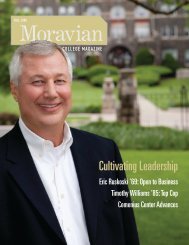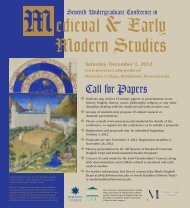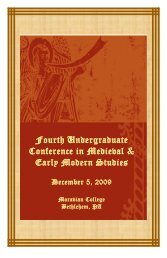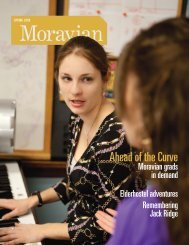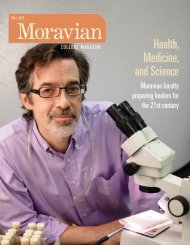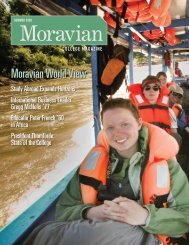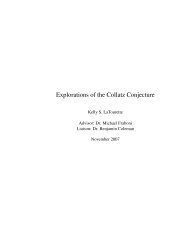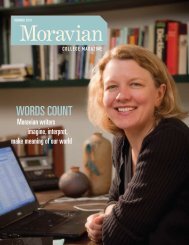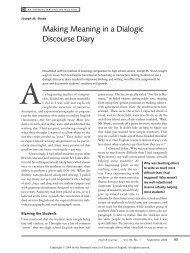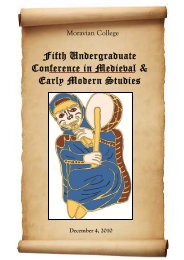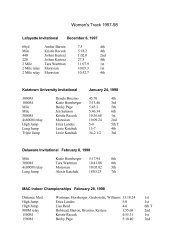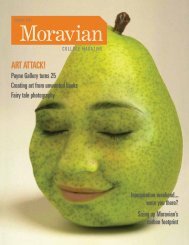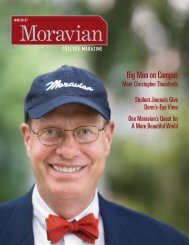MORAVIAN VISION - Moravian College
MORAVIAN VISION - Moravian College
MORAVIAN VISION - Moravian College
Create successful ePaper yourself
Turn your PDF publications into a flip-book with our unique Google optimized e-Paper software.
PHOTOS BY SARABETH BROCKLEY<br />
Reclaiming the Mountain<br />
A professor, a student, and a plant help<br />
regenerate a local Superfund site. By Kate Helm ‘05<br />
A<br />
n introductory environmental science course set junior Sarabeth<br />
Brockley, an art major at the time, on the path toward<br />
making a major contribution to the recovery of the Lehigh Gap<br />
Wildlife Refuge located at the Palmerton Zinc Pile Superfund site.<br />
Along with Diane Husic, chair and professor of biology, Brockley<br />
is studying the sandwort (Minuartia patula), a small annual<br />
plant that serves as an indicator of contamination and recovery.<br />
Their work is supported by <strong>Moravian</strong>’s SOAR (Student Opportunities<br />
for Academic Research) program. (See “SOARing Ahead,” below.)<br />
“Sandwort is not a native plant—it grows nowhere else in Pennsylvania. It is commonly<br />
found around old mine reclamation sites and areas with naturally high levels of heavy metals<br />
in western states,” explains Brockley, who is now majoring in environmental<br />
science and photography. “The plant can take up contaminants<br />
from the soil and potentially immobilize them within its tissues, while<br />
many other plants are intolerant of heavy metals and can’t survive.”<br />
Brockley collected random tissue samples of sandwort and soil and<br />
mapped the sites using Google Earth, then analyzed the samples to<br />
determine sandwort’s heavy metal uptake.<br />
Professor Husic has taken a special interest in the area’s recovery.<br />
The <strong>College</strong>’s partnership with LGWR, a 750-acre tract on the Kittatinny<br />
Ridge in eastern Pennsylvania, began in 2005 through a National<br />
Science Foundation grant and plant science consortium she co-directed.<br />
She has supervised three <strong>Moravian</strong> students whose research focused on the site.<br />
“Eighty years of zinc smelter air pollution resulted in a landscape almost devoid of vegetation,”<br />
explains Husic. “In 2003, metal-tolerant warm season grasses were tested as a potential<br />
way to re-vegetate the steep terrain, stabilize erosion, sequester the toxic metals, and serve as<br />
the first step in habitat restoration. Our hope is that the sandwort will serve as an indicator to<br />
see if this process is actually occurring. As the grasses spread and other plants become established,<br />
the sandwort may begin to disappear, a sign that the restoration is succeeding.”<br />
Brockley plans to continue her research during her senior year, then will attend graduate<br />
school. “Working with Professor Husic, I learned a lot,” she says. “SOAR makes important connections<br />
between students and professors, and supports research of statewide importance. I’m<br />
amazed I was able to spend my summer pursuing my passion for environmental science.” �<br />
SOARing Ahead<br />
The <strong>Moravian</strong> <strong>College</strong> SOAR (Student Opportunities for Academic<br />
Research) program provides stipends, travel allowances, and<br />
research expenses for scholarly or creative projects involving<br />
faculty members and students. “I am a huge proponent of involving<br />
undergraduates in research as a form of ‘doing the discipline,’”<br />
says Diane Husic, who worked with student Sarabeth Brockley on a<br />
summer 2008 SOAR project. “Wouldn’t it be wonderful if all students<br />
Top: Sarabeth Brockley maps the location of sandwort<br />
(shown below) and grasses at the Lehigh Gap site.<br />
had the opportunity for such individualized learning, working with<br />
a faculty member to solve problems together?” Major funding for<br />
SOAR is provided by the Ervin J. Rokke Endowment for Student-<br />
Faculty Research, established by a gift from <strong>Moravian</strong> trustee<br />
Priscilla Payne Hurd in honor of his service as <strong>Moravian</strong>’s president<br />
1997-2006. Supplemental funding comes from the <strong>College</strong>.<br />
FALL 2008 <strong>MORAVIAN</strong> COLLEGE MAGAZINE 17



